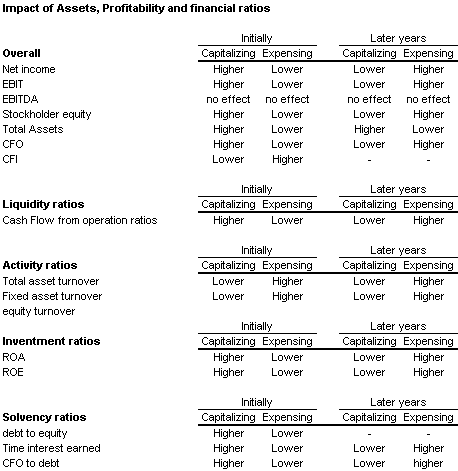CFA Level 1 - Assets
EFFECTS OF CAPITALIZING VS. EXPENSING
Expenses can be expensed as they are incurred, or they can be capitalized. A company is able to capitalize the cost of acquiring a resource only if the resource provides the company with a tangible benefit for more than one operating cycle. In this regard, these expenses represent an asset for the company and are recorded on the balance sheet.
Effects of Capitalization on Key Figures
The decision to capitalize or expense some items depends on management. As such, this choice will have an impact on a company's balance sheet, income statement and cash flow statement. It will also have an impact on a company's financial ratios.
Here is what the decision will have an impact on:
Net income - Capitalizing costs and depreciating them over time will show a smoother pattern of reported incomes. Expensing firms have higher variability in reported income. In terms of profitability, in the early years, a company that capitalizes costs will have a higher profitability than it would have had if it expensed them. In later years, the company that expenses costs will have a higher profitability than it would have had if it capitalized them.
Effects of Capitalization on Key Figures
The decision to capitalize or expense some items depends on management. As such, this choice will have an impact on a company's balance sheet, income statement and cash flow statement. It will also have an impact on a company's financial ratios.
Here is what the decision will have an impact on:
Net income - Capitalizing costs and depreciating them over time will show a smoother pattern of reported incomes. Expensing firms have higher variability in reported income. In terms of profitability, in the early years, a company that capitalizes costs will have a higher profitability than it would have had if it expensed them. In later years, the company that expenses costs will have a higher profitability than it would have had if it capitalized them.
- Stockholders' equity - Over a long time frame, the choice of expensing a cost or capitalizing it will have little effect on a shareholders' total equity. That said, expensing firms will have a lower stockholders' equity at first (less profit, thus smaller retained earnings).
- Cash flow from operations - A company that capitalizes its costs will display higher net profits in the first years and will have to pay higher taxes than it would've had to pay if it expensed all of its costs. That said, over a long period of time, the tax implications would be the same. But the choice for capitalizing over expensing have a much larger effect on the reported cash flow from operations and cash flow from investing. If a company expenses its cost it will be included in cash flow from operations. If it capitalizes, then it will be included in cash flow from investing (lower investment cash flow and higher cash flow from operations).
- Assets reported on the balance sheet - A company that capitalizes its costs will display higher total assets.
- Financial ratios - A company that capitalizes its costs will display higher profitability ratios at the onset and lower ratios in the later stages. Liquidity ratios will experience little impact, except for the CFO ratio, which will be higher under the capitalization method. Operation-efficiency ratios such as total asset and fixed-asset turnover will be lower under the capitalization method, due to higher reported fixed assets. Furthermore, at the onset, equity turnover will be higher under the capitalization method (lower total equity due to lower net profit). Companies that capitalize their costs will initially report higher net income, lower equity and higher total assets. Remember that, on average, an equal dollar effect on a numerator and denominator will produce a higher net result. That said, on average, ROE & ROA will initially be higher for capitalizing firms. Solvency ratios are better for firms that capitalize their costs because they have higher assets, EBIT and stockholders' equity.
Consider figure 8.2 below for an overview of the effect of capitalizing and expensing on key financial ratios.
Figure 8.2 Impact of Assets, Profitability on Financial Ratios
 |






0 comments:
Post a Comment